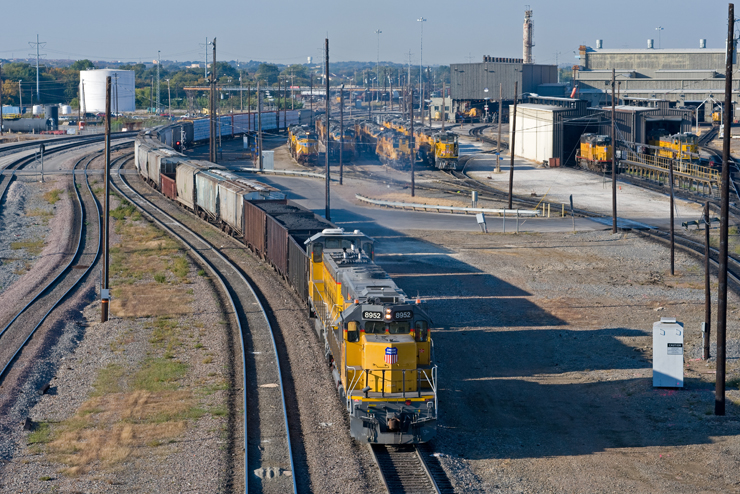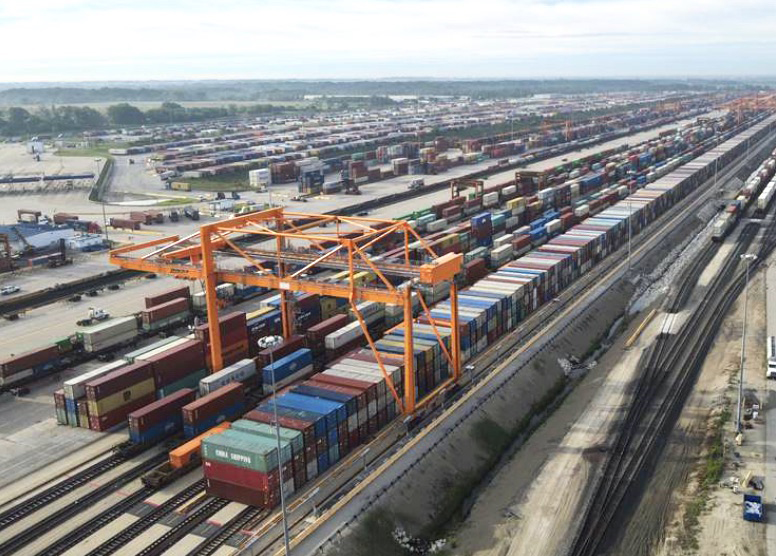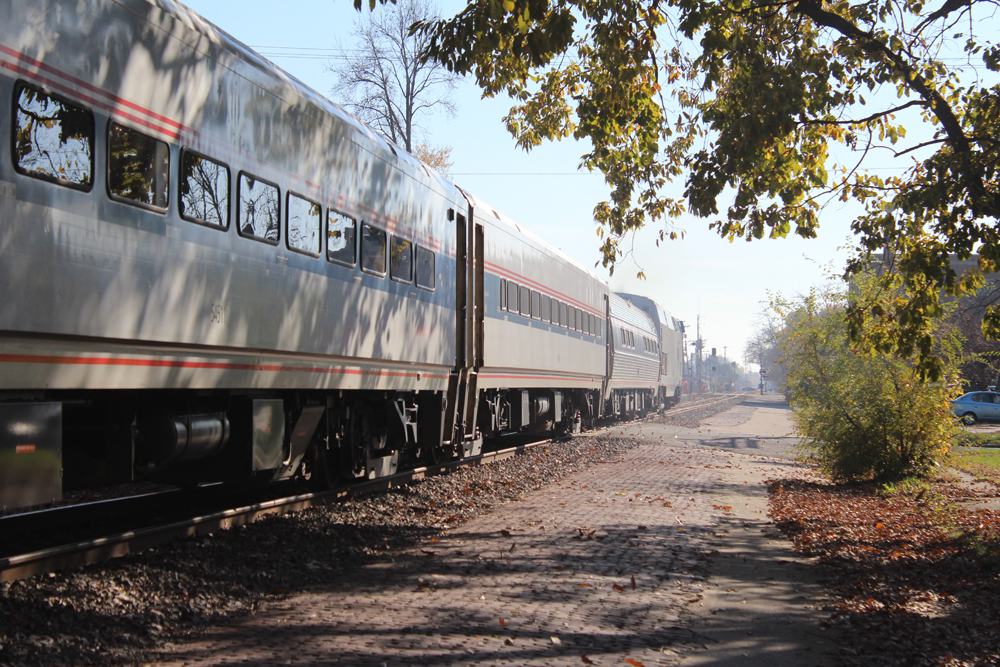
BALTIMORE – The blame for ongoing railroad service problems can’t be placed entirely on cutbacks related to Precision Scheduled Railroading. The pandemic, a surge in freight demand, and a labor shortage were a recipe for disruption all on their own.
That’s the message that Peter Swan, associate professor of logistics and operations management at Penn State Harrisburg, delivered at the North East Association of Rail Shippers conference last week.

“Any system that’s designed for maximum efficiency doesn’t do well with disruption,” Swan says of railroads as well as the global supply chains that stretch across continents and oceans.
Sudden increases in demand – like the tsunami of containers landing at U.S. ports beginning in late 2020 – quickly overwhelm an optimized system and cause delays, Swan explains.
When the supply chain slows down, it results in longer trip times, which require more resources. For railroads, that means more locomotives, crews, and freight cars. For intermodal operators, that means more chassis.
Labor shortages at warehouses had an impact at ports, railroads, and intermodal terminals. Chassis that carry international containers are in short supply because of longer turn times between intermodal terminals and warehouses. “If it takes eight days instead of six days, that means you need another 30% of chassis, which we don’t have,” Swan says. “As a result, we get congestion because containers are sitting at ports, they’re sitting at rail terminals. That lowers driver productivity. So, now we need more drivers than we had before.”

Last summer, this snowball effect produced congestion at the ports of Los Angeles and Long Beach and inland intermodal terminals, particularly in Chicago.
“Spikes in demand have overwhelmed existing capacity, and that counts for labor, that counts for equipment, and that counts for infrastructure,” Swan says. “The great resignation has made problems worse.”
A record number of Americans left their jobs last year in what economists have called the great resignation or the great retirement, which has exacerbated worker shortages. Railroads furloughed train crews as traffic sank at the onset of the pandemic, called them back slowly, and now find themselves short of crews in a tight job market.
“Labor shortages at rail are partly because the railroads laid off people, but they’re also partly because people have left and not come back,” Swan says.
Changing demographics make it likely that the tight labor market and challenging hiring conditions are not short-term issues for railroads because there are fewer young people available to take the place of retiring workers, Swan says.
Quality of life issues are becoming more important for employees, yet Swan notes that railroads are adopting more restrictive attendance policies for train crews. “It’s very difficult now for railroad crews to take time off or know when they can get time off,” he says, noting BNSF Railway’s new attendance policy, which is similar to one in place at Union Pacific.
“If the rail industry is to attract the people it needs, the bonuses like NS is offering are not going to be enough to attract and retain people,” Swan says. “They’re going to have to, at some point in the near future, address quality of life issues.”
Railroads also will have to address job satisfaction issues that arise from operational changes, Swan says. Crews are frustrated, for example, when they are headed uphill with a heavy train but aren’t permitted to fire up an idled unit in the consist and wind up stalling.
PSR: Both good and bad
Federal regulators have ordered BNSF, CSX Transportation, Norfolk Southern, and Union Pacific to appear at a two-day hearing this month on rail-service problems. Surface Transportation Board Chair Martin J. Oberman has blamed the service failures on a wave of PSR-related layoffs since 2017.
Swan, who has been a critic of PSR, doesn’t entirely agree.
“We’ve had Covid, we’ve had the great resignation which is affecting everyone, we’ve had the surge in demand. So is it PSR? Not entirely, for sure,” Swan says.
He adds: “Railroads didn’t do a great job of maintaining their pool of people. Is it their fault? I don’t know.”
Reductions in capacity – from smaller locomotive fleets and yard changes – and operational changes certainly have not helped rail service, Swan says.
“CSX is running trains now that are longer than any of the passing sidings,” Swan says, pointing to the controversy surrounding launching Amtrak service between Mobile, Ala., and New Orleans. “As a consequence, they have to fleet trains instead of having them meet anywhere. Well, they’ve reduced the capacity of that line dramatically.”
Railroads also have closed yards, turned hump yards into flat-switching facilities, and cut yard crews. “So the sorting capacity of the industry is now limited as well,” he says.
But Swan says many PSR practices are simply good management. The industry had too many hump yards. More restrictive demurrage policies have increased car velocity. And the use of longer, general-purpose trains has increased railroads’ asset utilization, he notes.
On the flip side, the reduction in crews and power limit railroads’ ability to respond to disruptions and traffic surges, he says. And reduced yard capacity has resulted in less reliable local service, partly because the use of longer road trains ties up yards and reduces the time available for switching. “This is an area where PSR, to make the linehaul part of the railroad function efficiently, has really hurt service to customers,” Swan says.














Prof. Swan:
It has been my contention for a very long time that the best thing that Class I’s could do is to contract their industrial and switching operations to shortlines. Simply turn over the pick up and set out of cars (“the first/last mile”) to a shortline partner and Class I’s do what they do best – take long trains from Point A to Point B.
We’ve all seen shortlines and contract switchers take over an operation from the big boys and substantially increase traffic, sometimes by factors of 2 or 3. I witnessed this myself back when I was employed with a shortline.
Is this not viable? Or is the pressure and power of unions, regulators, and front offices too great to overcome?
Railroad management is an convenient boogie man, but look past them to the shareholders who want money now and the railroad operated as if it is going out of business.
Look also at the federal tax system that treats short term capital gains more advantageously than regular income that ordinary people pay. It rewards money spinning and short term thinking.
Fine to reward people holding onto to ownership for the long haul, not fine to reward money spinning that benefits only those who are already more than comfortable.
“Railroad management” is an oxymoron like “government worker.”
My take on port congestion, specifically Long Beach/Port of LA, should have been the canary in the coal mine moment for UP and BNSF. Some basic research via google search on how many ships and what vessels were waiting on anchor for 30, 40, 50 or more days would probably have yielded a rough TEU count and throughput.
..
I just don’t buy the fact that the railroads didn’t know what they were up against with demand, especially in intermodal. They made a business decision for the containers to be off the vessel and stacked high before acting. Just as they made a decision to consolidate and centralize distribution point just as Global Logistics Center. Just as they have spent years and now decades purposely putting unit trains business over carload.
..
That same unit carload mentality is not even helping with the surge in grain export business due to the Ukraine war because of not having enough crews to keep the big unit grain trains moving fast enough for the demand…BNSF/UP should be crushing that biz. But hey, the inland waterway system will probably gain from it
Prof. Swan: should any carrier maintain an account to meet unexpected demands for service or economic opportunities that are yet to manifest themselves? I maintained just such an account for my business and called it a “power account”, in that I had the power to meet challenges. I used this to increase the security of my business. Blessings
Two parts to this. As a business practice any business should maintain some extra capacity. The questions is how much. There is a clear trade-off for the business. Most businesses got caught with too little inventory and a fragile supply chain in the pandemic. Competition and Wall Street pressure forces most businesses to keep costs as low as possible.
Second part is common carrier responsibility. How much surge capacity should railroads carry to properly protect their public service? How should the government enforce such extra capacity if railroads will not supply it on their own? Generally, incentives such as tax breaks and/or strategic supplies probably the most attractive economically. Third parties have been providing some surge capacity for locomotives and probably will continue to do so. Crews on the other hand are a tougher proposition. Again, there could be some sort of tax break for maintaining some extra capacity on extra boards might be helpful. Regulation could also be used to force reasonable days off for existing crews during most times with these employees available for surge capacity for short periods of time.
Problem is that extra capacity is difficult to measure and difficult to incentivize. Regulations that are too restrictive can also have unintended consequences.
PRR continued with dividends when it did not have profits to pay for them. Sucked the funds right out of maintaining the railroad.
The Maine potato debacle was a Penn Central production. When PC took over New Haven they quickly moved through freight from carfloats between Brooklyn and Jersey City to all rail via NYC Selkirk. Selkirk had not handled Maine potatoes before and didn’t know they needed heated (the cars had charcoal heaters) and Nobody reads a waybill which would have told them. The crop froze and many Maine farmers went broke. They never shipped by rail again.
And the potato story is now close to 40 years old, and the Maine potato farmers seem to be doing just fine without the stupid railroaders. How long has it been since the last Salad Bowl Express of National Geographic fame ran? We have evolved into a high service economy where J-I-T was defined as “Just-in-Truck”. Now they mantra is “Only-in-Truck”. BNSF is the preferred rail carrier of UPS because of the extraordinarily high level of on-time service they provide which has absolutely nothing to do with all the PSR silliness.
JAMES — Any one of us could post all day about shippers who have abandoned rail — or of spurs torn up from shippers still in business which means they’re 100% truck.
Miller Beer in Milwaukee is still very much in business. Its last outgoing carload of beer was maybe a decade ago.
As for “intermodal” it’s a euphemism for highway traffic. What happens to all those boxes coming off BNSF at Chicago? They’re hauled by road to Wisconsin, Indiana, Ohio and Michigan.
As long as we are picking on legacy PRR with stories…..perhaps this is myth, perhaps it really happened.
PennCentral is bankrupt. There were several yards full of box cars that were set aside due to misrouting or missing waybills, you name it. So the box cars are put up for auction or for scrap and some of them had apparently had been sitting in this yard for many years. Lots of rust as you worked your way back.
A gentleman won a bid for a box car that had its doors padlocked. The padlocks were rusty too, so this car had not been open in many years.
Cut the locks off, gets the doors open and inside were 3 brand new Hudson’s. Tires rotted out, but the interior still wrapped and each had 3 miles on the clock. If memory serves these were either 1956 or 1957 Nash built Hudson’s.
Seems these cars had been sitting for some 20+ years awaiting someone to come through and clean them out. Appears a BK auction finally did the work.
I am sure there is some Pennsy or PC expert who has the real skinny.
Let me clarify. My point was not on individual shippers but rather on the large segments of US industry that have abandoned the railroads. You bring up another class or segment of former rail users, the beer industry. The only brewers still using rail today that I know of is Corona out of Northern Mexico to Chicago. Not sure how much Coors still moves on rail. The nice thing about intermodal especially with JB Hunt is that it substitutes trucking management to run around many of the historical institutional rail problems. Is this the beginning of the end for conventional railroading and have we moved into a post-railroad world as railroads make themselves increasingly irrelevant to an increasing portion of the US economy.
Stock buy backs are definitely one problem. Will it take STB and FRA actions to require no train lengths over siding lengths on any route? As well the SEC might require RRs to stop buy backs and maybe even reduce dividends,
History has PRR continuing with dividends when it did not have profits to pay for them. Sucked the funds right of maintaining the PRR.
History had Sears continuing with dividends when it did not have profits to pay for them. Sucked the funds right out of maintaining the stores.
History had GM continuing with dividends when it did not have profits to pay for them. Sucked the funds right out of making new cars.
History had Lehman Bros continuing with securitizing home loans when it did not have paperwork to justify them. Sucked the capital right out of Wall Street.
It doesn’t end with railroads. Market greed has been around since the Dutch Tulip Crash in the 1600’s.
I believe that last infrastructure bill included funding for an FRA study of the effects of trains over 7,000 ft in length. Prelude to legislation on that subject?
I would add two more comments. Although many of the actions of Class I railroads have a foundation in reasonable business practices, the current strategy of pricing based on the value of service and shifting costs to customers is bad for the nation. Further, while the practice of cutting cost is good in the short-term, I can’t help but think that losing any semblance of customer focus will hurt the Class Is in the end.
“This is an area where PSR, to make the linehaul part of the railroad function efficiently, has really hurt service to customers,” Swan says.
And that sentence pretty much sums it up. A railroad like any business relies on customers to pay the bills. So if PSR isn’t providing good customer service then any customers that can will eventually find another way to transport their goods.
I believe one of two things will happen. Either the railroads will eventually drop PSR in order to try to stay in business or the federal government will step in and re-regulate in order to keep them in business. Just how bad it’ll need to get before this happens is anyones guess.
But the customers will ultimately vote with their feet and their transportation purchasing dollars. The railroads have just handed the inland waterways lobby a huge gift for the massive funding for improvements on the inland waterway system. How many commodity groups have left the railroads entirely? The meat-packing industry is one here in the Midwest. Potatoes out of the state of Maine is another. Raw material for the cereal industry in Cedar Rapids moves inbound by rail but now virtually all the outbound finished product moves by truck. We can certainly build more pipelines if the railroads can’t handle the load. If you’ve got it a truck brought it because the railroads were too stupid to figure out how.
I can’t take issue with most of what Prof. Swan says here with the exception of his improved velocity and asset utilization comments.
Velocity translates into the time it takes a railcar to move from actual placement at origin to empty release at destination. If velocity and asset utilization have improved with psr related demurrage policies and longer trains, why are shippers increasingly complaining about lousy service, longer transit times and an inadequate car supply?
Simple, reduced switches…instead of getting service 7 days a week or 5, now they only get 2 or 3 or 4…there in lies the problem.